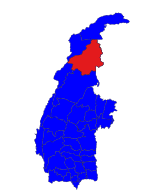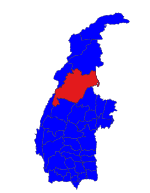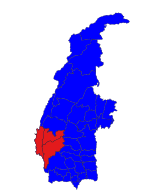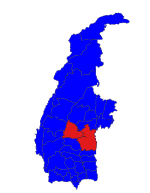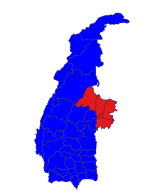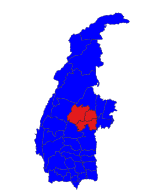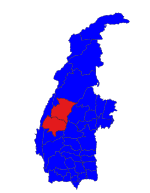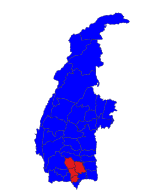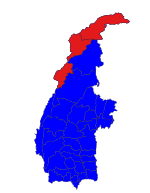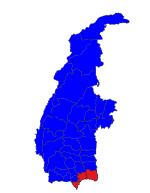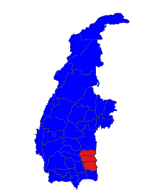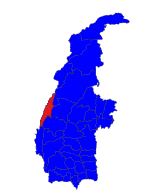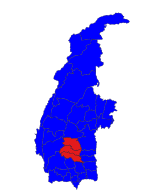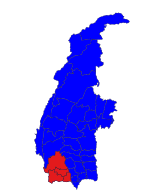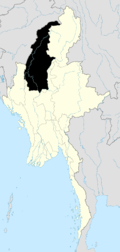إقليم زگاين
إقليم زگاين
စစ်ကိုင်းတိုင်းဒေသကြီး Sagaing Region | |
|---|---|
| الترجمة اللفظية بالـ Myanma | |
| • Burmese | cac kuing: tuing: desa. kri: |
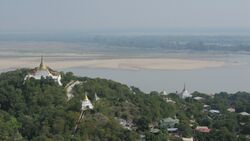 | |
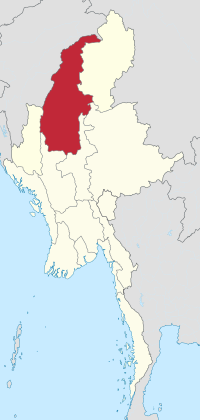 موقع إقليم زگاينگ في ميانمار | |
| الإحداثيات: 21°30′N 95°37′E / 21.500°N 95.617°E | |
| Country | Myanmar |
| Region | Central Northwestern |
| Capital | Monywa |
| الحكومة | |
| • Chief Minister | Myat Kyaw |
| • Cabinet | Sagaing Region Government |
| • Legislature | Sagaing Region Hluttaw |
| • Judiciary | Sagaing Region High Court |
| المساحة | |
| • الإجمالي | 93٬704٫5 كم² (36٬179٫5 ميل²) |
| ترتيب المساحة | 2nd |
| أعلى منسوب | 3٬841 m (12٬602 ft) |
| التعداد | |
| • الإجمالي | 5٬325٬347 |
| • الترتيب | 5th |
| • الكثافة | 57/km2 (150/sq mi) |
| صفة المواطن | Sagainggese |
| Demographics | |
| • Ethnicities | Bamar, Shan, Kuki |
| • Religions | Buddhism 92.2% Christianity 6.5% Islam 1.1% Hinduism 0.1% Animism 0.1%[2] |
| منطقة التوقيت | UTC+06:30 (MST) |
| ISO 3166 code | MM-01 |
| HDI (2017) | 0.547[3] low · 9th |
| الموقع الإلكتروني | sagaingregion |
إقليم زِگاين/ساجينغ/زغاين ( إنگليزية: Sagaing Region ؛ بالبورمية: စစ်ကိုင်းတိုင်းဒေသကြီး, تـُنطق [zəɡáɪ̯ɰ̃ táɪ̯ɰ̃ dèθa̰ dʑí]؛ سابقاً قسم زگاين Sagaing Division) هو إقليم إدارية في ميانمار، يقع في الجزء الشمالي الغربي من البلد بين خط العرض 21° 30' شمالاً وخط الطول 94° 97' شرقاً. ويحد الولايات الهندية ناگالاند, Manipur, and Arunachal Pradesh States to the north, Kachin State, Shan State, and Mandalay Region to the east, Mandalay Region and Magway Region to the south, with the Ayeyarwady River forming a greater part of its eastern and also southern boundary, and Chin State and India to the west. The region has an area of 93،527 متر كيلومربع (36،111 sq mi). In 1996, it had a population of over 5,300,000 while its population in 2012 was 6,600,000. The urban population in 2012 was 1,230,000 and the rural population was 5,360,000.[4] The capital city of Sagaing Region is Monywa.
العاصمة
The Capital city of Sagaing Region is Monywa.
التاريخ
The Pyu were the first to in recorded history to populate the area of Sagaing Region by the first century CE. The Burmans first migrated into Upper Myanmar by ninth century CE. The area came under the Pagan Kingdom certainly by the middle of 11th century when the King Anawrahta (r. 1044–1077) founded the Pagan Empire, which encompasses the modern day Myanmar.[بحاجة لمصدر]
After the fall of Pagan in 1287, the northwestern parts of Upper Myanmar came under the Sagaing Kingdom (1315–1364) ruled by Burmanized Shan kings. The area was ruled by the kings of Ava from 1364 to 1555 and the kings of Taungoo from 1555 to 1752. Konbaung Dynasty (1752–1885), founded by king Alaungpaya in Shwebo, became the last Burmese dynasty before the British conquest of Upper Burma in 1885. The area became Sagaing Division after the Burmese independence in January 1948.[بحاجة لمصدر]
In the aftermath of the 2021 Myanmar coup d'état, Sagaing Region, which is part of the Bamar homeland, emerged as a stronghold of resistance against military rule. Myanmar Armed Forces have engaged in significant military offensives throughout the region to quell resistance and intimidate local villagers. Sagaing Region has since become the site of several high-profile massacres by military forces, including the 2022 Let Yet Kone massacre and the 2023 Tar Taing massacre.[5][6]
التقسيمات الإدارية
As of 2022, Sagaing Region consists of 13 districts and 1 Self-Administered Zone divided into 34 townships[7] with 198 wards and villages. The major cities are Sagaing, Shwebo, Monywa, Ye U, Katha, Kale, Tamu, Mawlaik and Hkamti. Mingun with its famous bell is located near Sagaing but can be reached across the Ayeyarwady from Mandalay.
In August 2010,[8] three former townships of Hkamti District were transferred, in accordance with the 2008 constitution,[9] to a new administrative unit, the Naga Self-Administered Zone.[8]
الحكم
التنفيذي
هذا القسم فارغ. بإمكانك المساعدة بأن تضيف إليه. (July 2019) |
المجلس التشريعي
هذا القسم فارغ. بإمكانك المساعدة بأن تضيف إليه. (July 2019) |
القضاء
هذا القسم فارغ. بإمكانك المساعدة بأن تضيف إليه. (July 2019) |
الديمغرافيا
| السنة | تعداد | ±% |
|---|---|---|
| 1973 | 3٬119٬054 | — |
| 1983 | 3٬862٬172 | +23.8% |
| 2014 | 5٬325٬347 | +37.9% |
| Source: 2014 Myanmar Census[1] | ||
The Bamar (Burmans) are the majority ethnic group in the dry regions and along the Mandalay-Myitkyina Railroad. Shan live in the upper Chindwin River valley. Kuki people which includes the Thadou people in the south. Smaller ethnic groups native to the Region include the Kadu and Ganang, who live in the upper Mu River valley and Meza River valley. There are also an unknown number of Catholic Bayingyi people (at least 3,000), the descendants of 16th and 17th century Portuguese adventurers and mercenaries, who live in their ancestral villages on the expansive plains of the Mu River valley.
الدين
Religion in Sagaing (2015)[10]
According to the 2014 Myanmar Census, Buddhists, who make up 92.2% of Sagaing Region's population, form the largest religious community there.[11] Minority religious communities include Christians (6.6%), Muslims (1.1%), and Hindus (0.1%) who collectively comprise the remainder of Sagaing Region's population.[11] 0.1% of the population listed no religion, other religions, or were otherwise not enumerated.[11]
According to the State Sangha Maha Nayaka Committee’s 2016 statistics, 55,041 Buddhist monks were registered in Sagaing Region, comprising 10.3% of Myanmar's total Sangha membership, which includes both novice samanera and fully-ordained bhikkhu.[12] The majority of monks belong to the Thudhamma Nikaya (83.8%), followed by Shwegyin Nikaya (16.1%), with the remainder of monks belonging to other small monastic orders.[12] 9,915 thilashin were registered in Sagaing Region, comprising 16.4% of Myanmar's total thilashin community.[12]
البيئة
There are a number of protected areas in Sagaing Region, among them are Alaungdaw Kathapa National Park, Chatthin Wildlife Sanctuary,[13] Mahamyaing Wildlife Sanctuary,[14][15] and Htamanthi Wildlife Sanctuary in Homalin Township.[16]
النقل
Hemmed in by two great rivers of Myanmar, the Irrawaddy and the Chindwin, river transport is a common way to move people and cargo. Much of the inland Sagaing Region relies on roads and rail in poor condition.
الاقتصاد
Agriculture is the chief occupation. The leading crop is rice, which occupies most of the arable ground. Other crops include wheat, sesame, peanut, pulses, cotton, and tobacco. The region being next to India, depends on the export import business from India. It is the gateway to India for Myanmar. Sagaing is Myanmar's leading producer of wheat, contributing more than 80% of the country's total production. Important minerals include gold, coal, salt and small amounts of petroleum. Industry includes textiles, copper refining, gold smelting, and a diesel engine plant. The Region has many rice mills, edible oil mills, saw mills, cotton mills, and mechanized weaving factories. Local industry includes earthen pots, silverware, bronze-wares, iron-wares and lacquerware.
Forestry is important in the wetter upper regions along the Chindwin River, with teak and other hardwoods extracted. As in other parts of the country, reforestation is not effective enough to maintain sustainable forestry. Since the 2021 Myanmar coup d'état, illegal logging of teak and tamalan trees has surged in Sagaing Region, predominantly in key contested battlegrounds, including Kani, Yinmabin, Kantbalu, Indaw and Banmauk townships.[17] Both the Burmese military and resistance groups have profited from the illegal logging trade.[17] Smugglers transport the wood to India in order to circumvent Western sanctions, and use the Myanma Timber Enterprise to license the wood as being sourced from permitted areas.[17][18]
التعليم
Educational opportunities in Myanmar are extremely limited outside the main cities of Yangon and Mandalay. According to official statistics, less than 10% of primary school students in Sagaing Region reach high school.[19]
| AY 2002–2003 | Primary | Middle | High |
|---|---|---|---|
| Schools | 3854 | 190 | 84 |
| Teachers | 16,100 | 5000 | 1600 |
| Students | 550,000 | 140,000 | 49,000 |
Sagaing Region has three national "professional" universities in the Monywa University of Economics, Sagaing University of Education and the Sagaing Institute of Education. Monywa University is the main liberal arts university in the region. Sagaing Institute of Education also known Sagaing University of Education is the one of two senior universities of education in Myanmar.
الرعاية الصحية
The general state of healthcare in Myanmar is poor. The military government spends anywhere from 0.5% to 3% of the country's GDP on health care, consistently ranking among the lowest in the world.[20][21] Although healthcare is nominally free, in reality, patients have to pay for medicine and treatment, even in public clinics and hospitals. Public hospitals lack many of the basic facilities and equipment. Moreover, the healthcare infrastructure outside of Yangon and Mandalay is extremely poor. In 2003, Sagaing Region had less than a quarter of the number of hospital beds counted in Yangon Region, with a similar size of population.[22]
| 2002–2003 | # Hospitals | # Beds |
|---|---|---|
| Specialist hospitals | 0 | 0 |
| General hospitals with specialist services | 2 | 400 |
| General hospitals | 38 | 1168 |
| Health clinics | 48 | 768 |
| Total | 88 | 2336 |
المراجع
- ^ أ ب "The 2014 Myanmar Population and Housing Census Highlights of the Main Results Census Report Volume 2 – A" (PDF). The 2014 Myanmar Population and Housing Census - The Union Report - Census Report Volume 2 [EN/MY]. Department of Population Ministry of Immigration and Population. p. 6. Retrieved 2022-09-01.
- ^ "The 2014 Myanmar Population and Housing Census- The Union Report: Religion" (PDF). myanmar.unfpa.org. Department of Population Ministry of Labour, Immigration and Population MYANMAR. Archived from the original (PDF) on 29 March 2018. Retrieved 5 May 2021.
- ^ "Sub-national HDI - Area Database - Global Data Lab". hdi.globaldatalab.org (in الإنجليزية). Retrieved 2018-09-13.
- ^ http://www.mrtv3.net.mm/newpaper/68newsm.pdf Page 3 Col 1
- ^ Maung Shwe Wah (2023-03-11). "In Myanmar's heartland, new horrors from a junta struggling for control". Myanmar NOW (in الإنجليزية). Retrieved 2023-03-11.
- ^ "The Tabayin School Attack". Myanmar Witness (in الإنجليزية). 2022-11-23. Retrieved 2023-03-02.
- ^ "Myanmar States/Divisions & Townships Overview Map" Myanmar Information Management Unit (MIMU)
- ^ أ ب "တိုင်းခုနစ်တိုင်းကို တိုင်းဒေသကြီးများအဖြစ် လည်းကောင်း၊ ကိုယ်ပိုင်အုပ်ချုပ်ခွင့်ရ တိုင်းနှင့် ကိုယ်ပိုင်အုပ်ချုပ်ခွင့်ရ ဒေသများ ရုံးစိုက်ရာ မြို့များကို လည်းကောင်း ပြည်ထောင်စုနယ်မြေတွင် ခရိုင်နှင့်မြို့နယ်များကို လည်းကောင်း သတ်မှတ်ကြေညာ". Weekly Eleven News (in البورمية). 2010-08-20. Retrieved 2010-08-23.
- ^ ပြည်ထောင်စုသမ္မတမြန်မာနိုင်ငံတော် ဖွဲ့စည်းပုံအခြေခံဥပဒေ (၂၀၀၈ ခုနှစ်) (in Burmese) [0]=1|2008 Constitution PDF Archived 2011-05-01 at the Wayback Machine
- ^ Department of Population Ministry of Labour, Immigration and Population MYANMAR (July 2016). The 2014 Myanmar Population and Housing Census Census Report Volume 2-C. Department of Population Ministry of Labour, Immigration and Population MYANMAR. pp. 12–15.
- ^ أ ب ت The 2014 Myanmar Population and Housing Census Census Report Volume 2-C (PDF). Department of Population Ministry of Labour, Immigration and Population. July 2016. pp. 12–15.
- ^ أ ب ت "The Account of Wazo Monks and Nuns in 1377 (2016 year)". State Sangha Maha Nayaka Committee (in الإنجليزية الأمريكية). 2016. Retrieved 2021-01-19.
- ^ Aung, Myint (2001) "Ecology and Social Organization of a Tropical Deer (Cervus Eldi Thamin)" Journal of Mammalogy 82(3): pp. 836–847, DOI:<0836:EASOOA>2.0.CO;2 10.1644/1545-1542(2001)082<0836:EASOOA>2.0.CO;2
- ^ "Mahamyaing Wildlife Sanctuary" BirdLife IBA Factsheet
- ^ Brockelman, Warren Y. et al. (2009) "Chapter 20: Census of Eastern Hoolock Gibbons (Hoolock leuconedys) in Mahamyaing Wildlife Sanctuary, Sagaing Region, Myanmar" pp. 435–451 In Lappan, Susan and Whittaker, Danielle (eds.) (2009) The Gibbons: New Perspectives on Small Ape Socioecology and Population Biology Springer, New York, ISBN 978-0-387-88603-9, DOI:10.1007/978-0-387-88604-6_20
- ^ "Htamanthi Wildlife Sanctuary" BirdLife IBA Factsheet
- ^ أ ب ت Frontier (2023-03-27). "'No one can stop it': Illegal logging surges in Myanmar's conflict zones". Frontier Myanmar (in الإنجليزية الأمريكية). Retrieved 2023-03-27.
- ^ "From Taiwan to Turkey and beyond: How Deforestation Inc exposed the teak trade from Myanmar". ICIJ (in الإنجليزية الأمريكية). 2023-03-07. Retrieved 2023-03-27.
- ^ "Education statistics by level and by State and Division". Myanmar Central Statistical Organization. Archived from the original on 2011-09-29. Retrieved 2009-04-09.
- ^ "PPI: Almost Half of All World Health Spending is in the United States". 2007-01-17. Archived from the original on 2008-02-05.
- ^ Yasmin Anwar (2007-06-28). "Burma junta faulted for rampant diseases". UC Berkeley News.
- ^ "Hospitals and Dispensaries by State and Division". Myanmar Central Statistical Organization. Archived from the original on 2011-09-29. Retrieved 2009-04-11.
وصلات خارجية
- Pages using gadget WikiMiniAtlas
- CS1 البورمية-language sources (my)
- CS1 الإنجليزية الأمريكية-language sources (en-us)
- Short description is different from Wikidata
- Articles containing بورمية-language text
- Coordinates on Wikidata
- Articles containing إنگليزية-language text
- Pages using Lang-xx templates
- Articles with unsourced statements from August 2021
- Articles with hatnote templates targeting a nonexistent page
- Articles to be expanded from July 2019
- All articles to be expanded
- Articles with empty sections from July 2019
- All articles with empty sections
- Sagaing Region
- Regions of Myanmar


